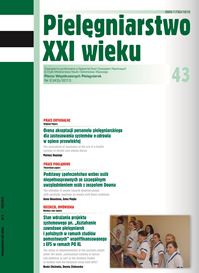Research tools for quality of life assessment of patients with cystic fibrosis
Słowa kluczowe:
mukowiscydoza, kwestionariusze, jakość życiaAbstrakt
RESEARCH TOOLS FOR QUALITY OF LIFE ASSESSMENT OF PATIENTS WITH CYSTIC FIBROSIS
Cystic fibrosis is a genetic disorder which a few years back was considered a fatal childhood disorder. Comprehensive, multispecialty treatment resulted in the increase of the number of adults with cystic fibrosis which in turn brings about a need to minimize clinical interventions. That is why health related quality of life surveys are ever more important. Constant and comprehensive monitoring of HRQoL should complement the assessment of clinical parameters. The analysis of QoL could make planning and arranging patient’s care possible and allow modification of therapeutic approach based on present physical, social and psychological needs of a patient. The term HRQoL was coined by Schippera et al. in 1900. It is a multidimensional concept which in its holistic approach to man is directly related to the definition of health developed by the WHO in which health is defined as a state of complete physical, mental, and social well-being. Since the 90s there has been an ongoing development of studies in the field of QoL of people suffering from various conditions. The research and analysis methods include qualitative and quantitative tools. Quantitative tools encompass QoL self-assessment surveys. General and specific questionnaires may be applied in patients with CF including respiratory diseases specific and cystic fibrosis specific questionnaires.
Bibliografia
1. Mazurek H. Mukowiscydoza 610 – 615, [w:]. Szczeklik A, red. Choroby wewnętrzne, stan wiedzy na 2010 rok. Medycyna Praktyczna. Kraków 2010.
2. Zalecenia Polskiego Towarzystwa Mukowiscydozy 2009 Poznań – Warszawa – Rzeszów. Zasady rozpoznawania i leczenia mukowiscydozy. Standardy Medyczne/ Pediatria. 2009; 6: 352 – 378.
3. Nowakowska A, Sands D, Piotrowski R i wsp. Okresy przeżycia chorych na mukowiscydozę. Pediatr.Pol. 1999; 74: 459 – 463.
4. Majka L, Pogorzelski A, Młynarczyk W i wsp. Sytuacja społeczna dorosłych chorych na mukowiscydozę w Polsce. Acta Pneumonologica et Allergologica Pediatrica. 1999;2:1, 8 – 11.
5. Stężowska – Kubiak S. Charakterystyka epidemiologiczno – kliniczna polskiej populacji chorych na mukowiscydozę. Rozprawa doktorska. Poznań: Uniwersytet Medyczny. 2011.
6. Dębska G. Jakość życia chorych na mukowiscydozę. Acta Pneumonologica et Allergologica Pediatrica. 2003; (6) 3: 39 – 42.
7. Ostrzyżek A. Jakość życia w chorobach przewlekłych. Probl Hig Epidemiol. 2008; 89:467 -470.
8. Dziurowicz – Kozłowska A. Wokół pojęcia jakości życia. Psychologia jakości życia 2002; 1(2): 77 -99.
9. Kłak A, Mińko M, Siwczyńska D. Metody kwestionariuszowe badania jakości życia. Probl Hig Epidemiol. 2012; 93(4): 632 – 638.
10. Schipper H. Quality of life: Principless of the clinical paradigm. Journal of Psychosocial Oncology. 8; 2/3:171 – 185.
11. Farnik – Brodzińska M, Pierzchała W. Znaczenie badań jakości życia w przewlekłych chorobach układu oddechowego w aspekcie holistycznego pojęcia medycyny. Wiad. Lek. 1998; 52:7 – 8.
12. Wołowicka L. (red.). Jakość życia w naukach medycznych. Poznań; 2001.
13. De Walden – Gałuszko K, Majkowicz M. Jakość życia w chorobie nowotworowej. Gdańsk: Wydawnictwo Uniwersytetu Gdańskiego; 1994
14. Chrobak M. Ocena jakości życia zależnej od stanu zdrowia. Problemy Pielęgniarstwa. 2009; 17(2):123 – 127.
15. Sokolnicka H, Mikuła W. Metody oceny jakości życia mające zastosowanie w medycynie. Medycyna rodzinna. 2003;3(4):129 – 131.
16. Trojanowska A. Znaczenie badań nad jakością życia w medycynie. Zdr. Publ. 2011; (121) 1: 99 – 103.
17. Dębska G. Badanie jakości życia pacjentów z przewlekłymi chorobami układu oddechowego. Acta Pneumonologica et Allergologica Pediatrica. 2003; (6) 2: 39 – 42.
18. Kaplan RM et al. The quality of well-being scale. Med Care. 1989; 27:1076-1083.
19. McEwen J, Hunt S, McKenna S. A measure of perceived health: the Nottingham Health Profile. [w:] Abellin T, Brzeziński ZJ, Carstairs VDI, red. Measurement in health promotion and protection. Copenhagen: World Health Organization. 1987: 590 -603
20. Ware JE, Kosinski M et al. SF -36 Health Survey: Manual and Interpretation Guide. Boston: The Health Institute, New England Medical Center; 1993.
21. The WHOQoL Group, The World Health Organization Quality of Life Assessment (WHOQoL): Development and general psychometric properties. Soc Sci Med. 1998; 46: 1569 -1585.
22. De Jong W. et al. Quality of life In patients with cystic fibrosis. Pediatri. Pulmonol. 1997; 23: 95-100.
23. Tobiasz-Adamczyk B, Owsiński J, Wojtowicz E. Jakość życia chorych z przewlekłymi chorobami układu oddechowego. Zdrowie Publiczne. 1999; 4: 133-137.
24. Jones PW et al. The St George’s Respiratory Questionnaire. Respir. Med. 1991; 85 suppl. B.: 25-31.
25. Lareau SC. et al. Development and testing of the modified version of the pulmonary functional status and dyspnea questionnaire (PFSDQ). Heart Lung. 1998; 27:159-68.
26. Kaplan RM Et al. Validation of a new dyspnea measure. The UCSD shortness of breath questionnaire. Chest. 1998; 113:619-24.
27. Gee L et al. Development of a disease specific health related quality of life measure for adults and adolescents with cystic fibrosis. Thorax. 2000; 55: 946-954.
28. Dębska G, Mazurek H. Kwestionariusz CFQoL jako narzędzie oceny jakości życia chorych na mukowiscydozę. Pol. Merkuriusz Lek. 2007;23:340 – 343.
29. Henry B, Aussage P, Grosskopf C et al. Development of the Cystic Fibrosis Questionnaire (CFQ) for assessing quality of life in pediatric and adult patients. Qual Life Res. 2003;12(1):63-76.
30. Goldbeck L et al. Questions on Life Satisfaction for Adolescents and Adults with Cystic Fibrosis. Chest. 2003; 123: 42-48.
Pobrania
Opublikowane
Numer
Dział
Licencja
Prawa autorskie (c) 2013 Izabella Uchmanowicz, Beata Jankowska-Polańska, Marta Wleklik (Autor)

Utwór dostępny jest na licencji Creative Commons Uznanie autorstwa 4.0 Międzynarodowe.




